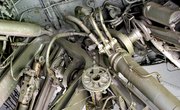
Pneumatic systems are mechanical systems that use compressed gasses. They are similar to hydraulic systems, which are mechanical systems that use liquids in the transfer of forces. Pneumatic systems are almost everywhere in the modern world. Dentists use pneumatics to operate drills, carpenters use pneumatics to power air hammers, truckers use pneumatic brakes and NASA uses pneumatics to control the operation of satellite launch vehicles.
Basic Principles
A pneumatic definition would state that a pneumatic system is basically a method to turn electricity into mechanical motion using compressed gasses instead of motors or electromagnets. For many applications, this is much more efficient and practical. Systems typically include an air compressor, which stores compressed air in a cylinder and releases the compressed air under electric control. The compressed gas is almost always ordinary air because it is free and non- toxic. Often the air is slightly modified by taking out some of the water vapor and adding a small amount of atomized oil to make the gas more machine friendly.
Applications of Pneumatic Power
Pneumatics systems are widely used for power tools. The power tool that an automobile mechanic uses to take the lug nuts that hold a tire onto the hub is one example. The mechanic can easily take off even the toughest nuts in just a few seconds. There are dozens of other pneumatic power tools in dentistry, carpentry, machine shops and laboratories. Other applications include jackhammers, the cylinder delivery systems used by some banks and various launchers and guns designed to propel objects. One interesting application is a new French automobile that runs on compressed air. Electricity is used overnight to compress air into an on-board cylinder and the car runs all day with no fuel and no pollution emissions.
Pneumatic vs. Hydraulic
Hydraulic systems usually use oil as the control fluid. Hydraulic systems have the advantage that they can handle bigger loads, and the disadvantage is that if there is a leak it causes a big mess and is expensive to fix. A leak in a pneumatic system means that you vent ordinary air, which can be replaced for free when the leak is fixed. Pneumatic systems are preferred when there must be a certain amount of "give" or "play" in the system (gasses are compressible). Hydraulic systems are preferred when high pressures must be maintained with no fluctuation.
High-Tech Applications
Pneumatic power is not a dying technology--far from it. There are at least two high-tech applications of pneumatics that have a place in our technological future: McKibbens and pneumatic logic systems. McKibbins are sometimes called "artificial muscles." They are inflatable rubber tubes surrounded by a wire mesh. When inflated they contract and then elongate when deflated. They are currently being used to power robotic arms and legs. Pneumatic logic is the use of complex channels for fluids that act like simple computer circuits. Pneumatic logic systems have many advantages over electronic systems such as the fact that radiation does not interfere with them. These systems are currently being used by NASA to control rocket-stage separation.
